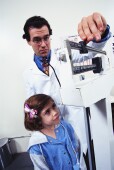
MONDAY, Dec. 10 (HealthDay News) — Primary-care doctors should offer children and teens counseling and educational programs to prevent them from smoking, according to new recommendations issued by the U.S. Preventive Services Task Force.
This type of intervention is effective in preventing young people from lighting their first cigarette, found the U.S. Preventive Services Task Force (USPSTF), which is comprised of national experts in prevention and evidence-based medicine.
Although the task force cannot mandate that doctors offer these anti-smoking interventions, the guidelines it issues tend to shape clinical practice and, in many cases, affect insurance coverage.
“As a pediatrician, I believe preventing tobacco use is critical in helping young people to live long, healthy lives,” USPSTF member Dr. David Grossman said in a task force news release. “The good news is that primary-care clinicians can play an important role in preventing tobacco use among their young patients.”
Every day, nearly 4,000 young people aged 12 to 17 smoke for the first time, and 1,000 young people also become daily smokers. Kids as young as 10 years old may be vulnerable to smoking, the recommendations noted. Although it may take up to two years for them to become addicted, some children become dependent on nicotine more quickly.
Being counseled by their doctor individually, with their family or in a group setting can help prevent children and teens from smoking, evidence showed. Talking on the phone with their primary-care doctor also can reduce kids’ risk of using tobacco, the task force found.
Computer applications and mailed print materials, such as activity guides, newsletters and tip sheets, had significant effects on the decision to start smoking among children and teenagers. Even preprinted prescription forms with anti-tobacco messages helped prevent kids from smoking.
Patricia Folan, director of the Center for Tobacco Control at North Shore-LIJ Health System in Great Neck, N.Y., welcomed the new report.
“Review of currently available research on youth tobacco use prevention and cessation is an important exercise to determine which strategies may be effective in addressing tobacco use initiation and smoking among children and adolescents,” she said.
Among topics covered in the anti-smoking interventions for kids were their attitudes, beliefs and knowledge about smoking, as well as its harmful effects. The interventions also addressed how the children’s social environment influenced their decisions about smoking, how tobacco products are marketed and how to develop skills to say no to cigarettes. Some interventions also touched on parents’ attitudes about smoking.
“Many of these interventions are brief, low-cost and easy to implement in primary care, with potentially lifesaving results for these teens,” Grossman said.
The task force also recommended that doctors ask all pregnant women about their tobacco use and provide pregnancy-tailored counseling to help those who smoke quit.
The full report appeared online Monday on the USPSTF website. It also is available in the Dec. 11 online edition of the Annals of Internal Medicine.
But Folan said more efforts are needed to curtail youth smoking.
“Although the article provides a great deal of information, evaluation of the long-term effects of smoke-free policies, anti-smoking media campaigns, increased taxes on cigarettes and decreased marketing of tobacco products to children is also needed,” she said.
“These comprehensive policies are more likely to impact the initiation and cessation of children and young adults,” she added. She also noted, however, that “many other harmful tobacco products such as cigars, smokeless tobacco, hookah pipes and bidis are gaining in popularity.”
“Future study regarding the perception and use of these products — particularly among young people — is warranted,” Folan concluded.
More information
The American Cancer Society provides a guide on how to quit smoking.

